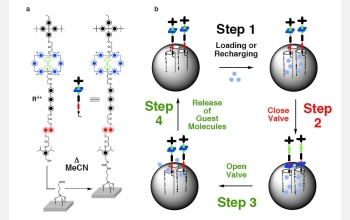News Release 05-121
An Open and Shut Case at the Nanoscale
New nano-valve can start and stop a molecular flow repeatedly

The stick-like rotaxane molecule is surrounded by a ring that can move up and down.
July 19, 2005
This material is available primarily for archival purposes. Telephone numbers or other contact information may be out of date; please see current contact information at media contacts.
Chemists at UCLA have created the first reversible nano-valve: a molecular machine that they can open and close like a faucet whenever they want. Among the many potential applications are nanoscale drug delivery systems that could release pharmaceuticals at very precise points within the body, or even within a single cell.
UCLA chemist Jeffrey Zink and his colleagues based their valve on rotaxane: a molecule that will switch back and forth from one stable configuration to another depending on its chemical environment. They collaborated with a team led by Fraser Stoddart, director of the California NanoSystems Institute at UCLA, who has already shown how these switchable rotaxanes can be used in molecular electronics.
The development of the new valve was supported by a Nanotechnology Interdisciplinary Research Team Grant from the National Science Foundation. Zink, Stoddart and their coworkers published their results in the July 8, 2005, online edition of The Proceedings of the National Academy of Sciences, and in the July 19, 2005, print edition of that journal.
For more information, see the UCLA news release.
-NSF-
Media Contacts
M. Mitchell Waldrop, NSF, (703) 292-7752, email: mwaldrop@nsf.gov
Stuart Wolpert, UCLA, (310) 206-0511, email: stuartw@college.ucla.edu
Program Contacts
Filbert J. Bartoli, NSF, (703) 292-8339, email: fbartoli@nsf.gov
Principal Investigators
Jeffrey I. Zink, UCLA, (310) 825-1001, email: zink@chem.ucla.edu
Fraser Stoddart, UCLA, (310) 206-7078, email: stoddart@chem.ucla.edu
Related Websites
UCLA News Release: http://newsroom.ucla.edu/page.asp?RelNum=6306
California Nanosystems Institute: http://www.cnsi.ucla.edu/mainpage.html
The PNAS article, "A Reversible Molecular Valve": http://www.pnas.org/cgi/reprint/0504109102v1
The U.S. National Science Foundation propels the nation forward by advancing fundamental research in all fields of science and engineering. NSF supports research and people by providing facilities, instruments and funding to support their ingenuity and sustain the U.S. as a global leader in research and innovation. With a fiscal year 2023 budget of $9.5 billion, NSF funds reach all 50 states through grants to nearly 2,000 colleges, universities and institutions. Each year, NSF receives more than 40,000 competitive proposals and makes about 11,000 new awards. Those awards include support for cooperative research with industry, Arctic and Antarctic research and operations, and U.S. participation in international scientific efforts.
Connect with us online
NSF website: nsf.gov
NSF News: nsf.gov/news
For News Media: nsf.gov/news/newsroom
Statistics: nsf.gov/statistics/
Awards database: nsf.gov/awardsearch/
Follow us on social
Twitter: twitter.com/NSF
Facebook: facebook.com/US.NSF
Instagram: instagram.com/nsfgov


